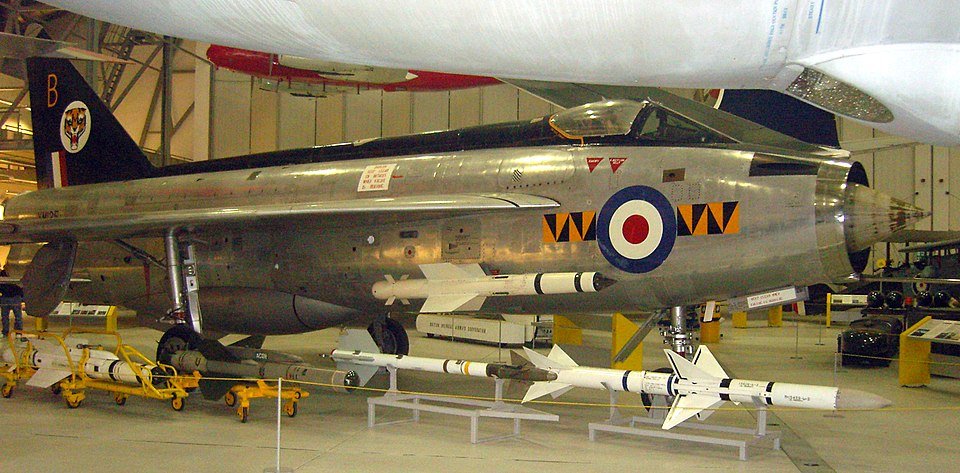Britain’s Sonic Spear: The English Electric Lightning
Few aircraft capture the imagination like the English Electric Lightning. With its blistering climb rate, distinctive stacked engines, and ability to fly at Mach 2, it wasn’t just Britain’s first—and only—homegrown supersonic interceptor, but a true icon of the Cold War. Nicknamed “The Sonic Spear,” the Lightning combined raw power with a unique design that made it an aviation marvel and, at times, the star of hair-raising stories.
A Radical Design for a New Age
When the Lightning was conceived in the late 1940s, Britain was determined to leapfrog the competition and create a fighter that could intercept Soviet bombers at unprecedented speeds. English Electric’s design team, led by W.E.W. “Teddy” Petter, produced a radical solution: two Rolls-Royce Avon turbojets stacked one atop the other inside a slim fuselage. This arrangement minimized drag and gave the aircraft a phenomenal power-to-weight ratio, but required a complex air intake system and a novel twin-fin tail to control the jet’s extreme performance.
The first prototype, known as the P.1A, took to the skies in 1954. On August 25, 1954, it stunned observers by breaking the sound barrier on only its third flight. By the time the Lightning entered service as the F.1 in 1960, it could fly faster than Mach 2 and climb faster than any other aircraft in NATO, rocketing from takeoff to 30,000 feet in under three minutes.
Unmatched Performance—and Challenges
Pilots who flew the Lightning loved its raw speed and power. In mock dogfights, it could outclimb and out-accelerate almost anything. Its top speed of 1,500 mph made it one of the fastest aircraft ever to serve with the Royal Air Force. But it also had limitations: it guzzled fuel so rapidly that endurance was often measured in minutes, not hours. Some pilots joked that a Lightning could cross the English Channel—if it didn’t have to come back.
Its radar and missiles were advanced for their day, optimized for high-altitude interception of Soviet bombers. Despite its intended role, Lightnings often found themselves tangled in air defence scrambles chasing unidentified aircraft over the North Sea, where their astonishing speed was both an asset and a constant logistical headache for ground controllers trying to coordinate intercepts.
The Accidental Passenger: A Lightning Legend
One of the most memorable stories in the Lightning’s history occurred on July 22, 1966, at RAF Lyneham. Wing Commander Walter “Taffy” Holden was performing ground engine tests on a Lightning F.1, but a series of mistakes led to a scenario worthy of a comedy sketch—if it hadn’t been deadly serious. During the test, Holden inadvertently pushed the throttle past the afterburner gate and found himself accelerating down the runway. Realising the Lightning would overrun the airfield, he decided his only chance was to take off.
The canopy had been removed, ejection seat locked in position, and Holden had no helmet or flight gear—and he wasn’t even qualified to fly the Lightning solo. He had learned to fly on a Tiger Moth and other light aircraft, so he had some piloting skills. Miraculously, Holden managed to control the jet, fly a wide circuit, and land it safely back on the runway after the third attempt.
The aircraft at the centre of this amazing story, XM135, can still be seen at The Imperial War Museum, Duxford.
The Lightning Legacy
Operationally, the Lightning served the RAF from 1960 until its retirement in 1988, protecting Britain’s skies through some of the tensest years of the Cold War. It was deployed in both UK-based squadrons and overseas, notably in RAF Germany, where it was a key part of NATO’s first line of defense. It also flew with the Kuwait and Royal Suadi Air Forces.
As it aged, the Lightning underwent upgrades to the F.3 and F.6 variants, which improved its range, avionics, and weapons. But no matter the version, pilots continued to relish its near-rocket-like acceleration and the thrill of sitting atop two roaring jet engines.
In the decades since retirement, the Lightning’s legend has only grown. A few examples remain airworthy today in private hands or are regularly taxied at the Lightning Preservation Group at Bruntingthorpe. Hearing its engines light up, even at ground level, is an unforgettable experience for aviation enthusiasts. Other examples are preserved at various museums, including the RAF Museum Cosford.
Conclusion
The English Electric Lightning was more than just a fast jet; it was a technological marvel that pushed Britain to the forefront of supersonic flight. With its unmatched climb rate and twin-engine thunder, it defended British airspace during some of history’s most uncertain years. And thanks to stories like the accidental takeoff with an unsuspecting engineer, the Lightning’s reputation is as colourful as it is impressive—a testament to an era when speed, daring, and innovation ruled the skies.
Photo credit: Roland Turner

